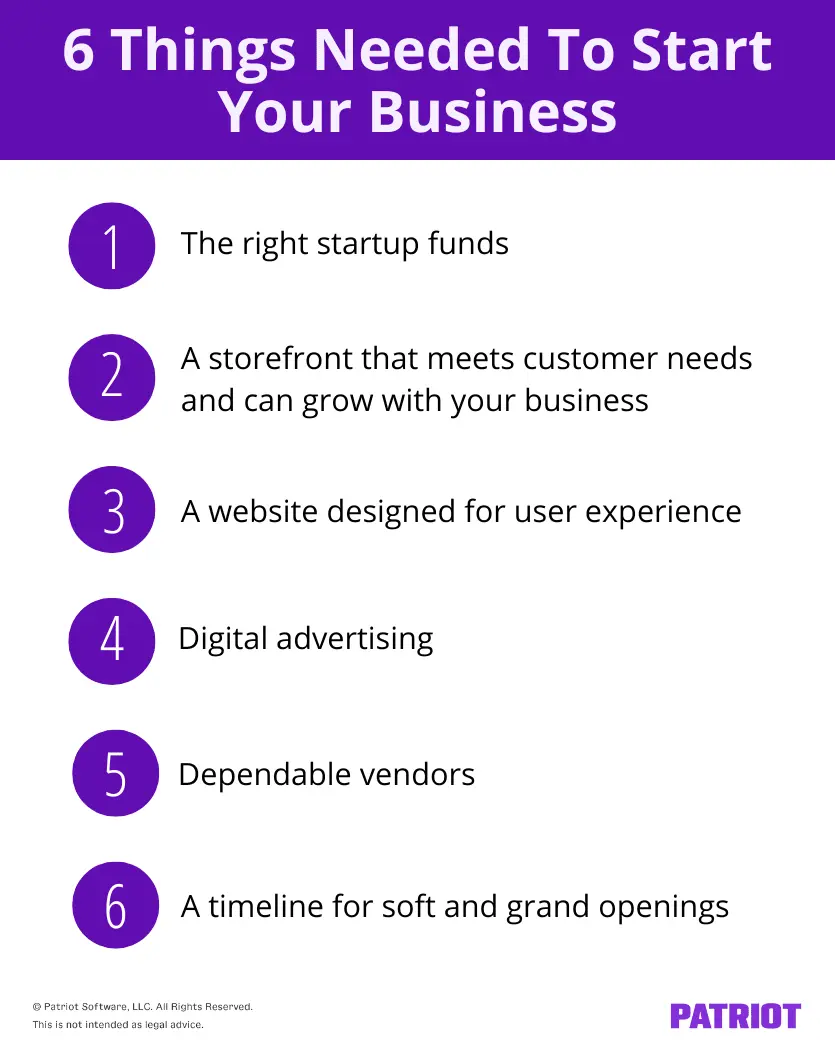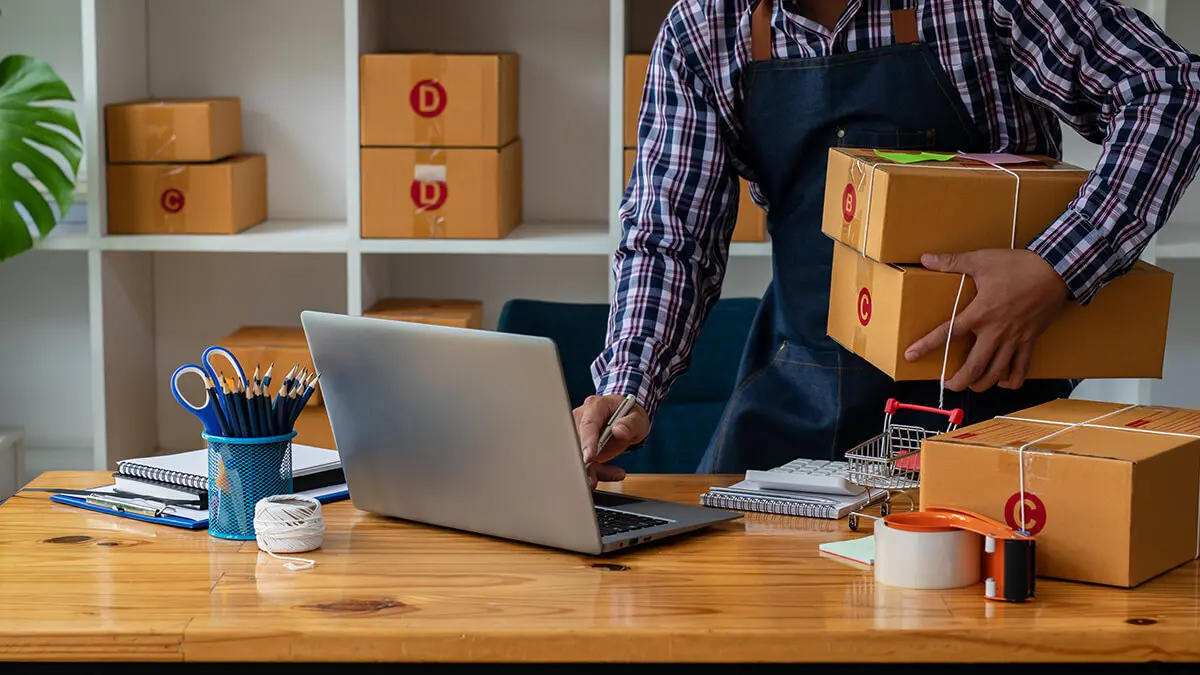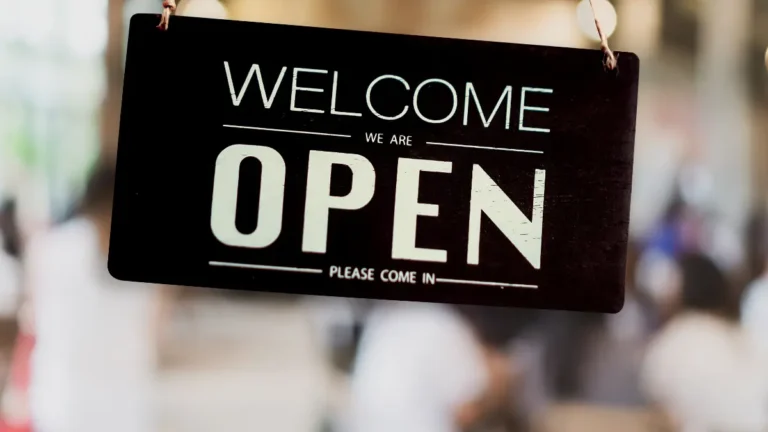If you’re thinking about starting a business, you’ve probably seen the business startup checklists online and already know them like the back of your hand. Make a plan. Choose a business structure. Secure funding. Register your business name. But what about the tangible things you need to start a business, like a storefront or startup funding? You also need these things to get your business off the ground. Read on for our list of things needed to start a business.
List of things needed to start a business
It’s exciting to start a business. You can make your dream a reality and finally do what you love. But, the moments leading up to your opening day can also feel stressful and complicated. Set yourself up for success with this list of things needed to start a small business.

1. Startup funds
You may need some cash to help fund your business. If you have some saved away, that’s great. If you don’t, no sweat. There are plenty of ways to secure funding to help start your business.
Here are some funding sources you should keep in mind:
- SBA programs
- Business associations
- Grants and loans
- Private investors
What if you don’t have funding and don’t want to get any? You can still start a business without a surplus of cash. It just depends on what you want to do. For example, dropshipping and print-on-demand can help you create a business from your computer with low upfront cash.
2. Storefront
Brick-and-mortar storefronts are still thriving. Eighty-seven percent of retail sales take place in-store. A physical storefront is a great way to connect with your customers, add to your local community, and make the sale. So, what should you look for when deciding on the perfect brick-and-mortar store?
When shopping around for a storefront, keep the following in mind.
Want to take your storefront on the road instead? Read our article on how to run a food truck to get started!
Location
You’ve heard the real estate saying: “It’s all about location, location, location.” The same is true for a business. The perfect store means nothing if you don’t have foot traffic.
When looking for the perfect location, here are some questions to ask:
- Is the store in a good spot for my customers?
- Does it have regular or seasonal foot traffic?
- Is parking easily accessible and large enough to fit my needs?
- Does the building meet local building codes?
- Is it within my budget?
Interior setup
Depending on what business real estate you look at, you may find stores in all stages of development. From initial planning stages to an older store that’s already seen different businesses come and go.
If you are looking at buildings that have been used before, ask yourself these questions to see if it’s right for you:
- Can I use the store as is, or do I need to renovate it?
- Is a possible renovation in my budget?
- Can I afford to look around for something that immediately fits my needs?
If your storefront is off the beaten path, you may have to work harder to make the outside of your storefront eye-catching and appealing. Just make sure that your budget can handle any surprises that may pop up.
Exterior setup
The exterior of your store is just as important as the interior. It’s the first thing that customers will see, after all. Storefronts with high visibility can act as billboards. Fresh coats of paint and eye-catching signs can quickly bring new customers into your store. If your storefront is off the beaten path, you may have to work a bit harder to make the outside of your storefront eye-catching and appealing.
Here are some questions to consider when sizing up the exterior of a new business:
- Is the store easy to see from the street or sidewalk, or is it tucked away and hard to see?
- Is there adequate lighting outside (e.g., for customer safety and advertising)?
- Will customers need additional directions to find your front door (e.g., “tucked behind the fire station”)?
Space
Make sure the new space is big but not too big. After all, you’re paying for the space whether or not you use it. Remember that you’ll need some amount of storage space. The size of your storage space depends on your needs.
It may be smart to plan for what your business will need down the road. The extra space you have for the first year may be perfect after your second or third year.
3. Website
Seventy-one percent of small businesses have websites. Your new business should, too. You don’t have to hire anyone to set up your store’s website. You can do it yourself with a little elbow grease and the right mindset.
Keep the following things in mind to get started.
Responsive design
Responsive web pages work on all types of devices. Whether shoppers use a computer, tablet, or phone, they’ll have a similar experience. Why does this matter? Seventy-six percent of shoppers report frequently using their phones to shop online. And, 69% of online shoppers use a computer.
Responsive design makes sure all of your online shoppers can easily view your webpage.
User-friendly design
A lot of things can go into user design, from page layout to the size of your fonts. But designing your store’s webpage doesn’t have to be complicated.
To keep things simple, make sure that you:
- Use clear product pictures and concise product descriptions
- Place shopping cart and checkout buttons in easy-to-find locations
- Let users post product reviews
Multiple payment methods
Online shoppers are used to having plenty of payment options online. Display the accepted payment methods clearly when a customer checks out. Credit cards are a must, but don’t forget about mobile payment options. If a customer is shopping on their phone, mobile payment options make payments as easy as possible.
Shipping and return information
The worst thing for an online store is when customers abandon their shopping cart before making a purchase. And here’s the hard truth: almost 70% of shoppers do. One of the main reasons this happens is the unexpected shipping fee. Take the guesswork out of your pricing by clarifying your shipping fees as soon as an item is put in the shopping cart. If that sounds too complicated, consider getting rid of shipping fees altogether.
Contact information
The customer experience doesn’t end with the purchase of a product. Customers may need to ask questions about products, shipping, or returns. Whatever the case, make sure they can get a hold of you through multiple channels (e.g., chat, email, and phone). And, don’t forget to respond to customers as quickly (and happily) as you can.
4. Advertising
Getting your brand in front of customers can feel daunting, but it isn’t possible. If you’re unsure about creating a complete merchandising campaign for your company, you can still do a few things to get a foot up on the competition.
Here are some of the easiest (and cheapest) ways to get the word out about your business:
- Set up a Google Business account. This way, you’ll show up in local searches. When setting up the account, use up-to-date contact information and post your store hours.
- Create social media accounts for your business. Ninety-one percent of companies have two or more social media accounts. Social media is a great way to stay in touch with customers, expand your reach, and promote sales and new merchandise.
- Add local search engine optimization (SEO) to your online store. Local SEO will help you turn up in searches when customers are looking for nearby shopping options. You can use local SEO by:
- Adding location-based keywords to titles, headings, and the body content of your main website pages
- Listing your business in online directories
- Publishing blog posts specific to the areas you serve
5. Vendors
When starting a business, you’ll need vendors to supply you with the products you sell or the items required to make your products. Unfortunately, not all vendors are trustworthy or up to the task.
When shopping around for vendors, make sure that the prospective vendors:
- Aren’t new to your product category or industry
- Can scale and grow with your business
- Have a good track record
6. Timeline for your soft and grand opening
Once you’ve finished going through your list of things you need to start a business, you’ll need to set a date to open your doors. Opening day isn’t a chance to set a sales record. But it is a chance to meet the locals, get the word out, and put your best foot forward.
There are two types of opening days for a business: a soft opening and a grand opening.
Soft opening
A soft opening is a business opening that is either unannounced or lightly announced to the public. Think of a soft opening as a way to ensure all wrinkles are ironed out of your business before a grand opening. Soft openings let you and your employees get a feel for how business will go and can help make sure that all of your technology, from your point-of-sale system to your plumbing, is up to snuff.
Who do you invite to your soft opening? Friends and family are always a great choice, but you can also be more strategic. Consider inviting local business owners, local media, and any social influencers in your area. That way, you can get the feedback you need for the grand opening and get help in spreading the word.
Grand opening
Your grand opening should be a celebration of your business. So think of it like one. Go big, shake hands, and don’t forget to have fun.
Here are a few ways you can make your grand opening feel like a party and be something that your customers won’t quickly forget:
- Track the countdown to your grand opening on social media
- Offer special one-time gifts with purchases (e.g., branded swag)
- Run a giveaway or a contest
- Hire a local band
- Showcase local food
- Get creative (Is a parade too much?)
- Start a fundraiser for a local charity (e.g., proceeds from the night go to the charity)
After the grand opening, the real work begins, like keeping track of your expenses and income. Patriot built its online accounting software for small business owners. Easily record payments and import data, and so much more. Try it for free today!
This is not intended as legal advice; for more information, please click here.



